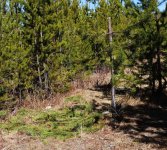I have been away for a long time and see that there is still interest in the legend. First lets deal with stories of treasure from four states, Western Virginia, West Virginia, Kentucky and Tennessee. Since around 1632 there have been Spanish, French and English Explorers Searching in these four states for mineral wealth, of course the native American Indian tribes new of locations that held wealth in the ground and suffered severe cruelties because of this knowledge. Each state has a list of stories of hidden treasure and thats the problem. Over the years something is found, a piece of ore, a vein, bars and coins and the first thing that happens is, it must belong to swift and his Merry men and several stories become part of the Swift legend. As time passes the stories are changed or added to. So what is true. I worked for two long years, reading and rereading the legend of John Swift. Going to one location after another. Remember the stories you read in books are only a guide. Do the Research.
until one day i saw a topo map at the library. Ahhhhhh and i started to learn how to go about being smart.
The Swift Mines: I started by looking at all the stories on the subject and using a map of each state, pin pointed the areas of interest. I found that several stories were vary close to Indian trails or buffalo trails. One goes east and west, the crossing point is Fort Gay WVA. at the forks of sandy and goes toward Lexington KY. The other of interest runs along Route 23 from Johnson city Tenn. to a fork that heads west to Cumberland Gap. The north fork goes along Route 23 to Castlewoods VA. and on to the pound gap into KY. At the forks of sandy a branch of this buffalo trail goes southwest along the west fork of sandy to Paintsville KY. and then heads west. By the way, Route 460 was built on this buffalo trail. The old Route 23 from Paintsville to Pound Gap was part of an Indian or buffalo trail.
Maps: Shaded Relief Topo Maps and Aerial Photo Maps will save a lot of gas and shoe leather. For fine maps of all kinds for Kentucky go to this site (Kentucky Geography Network).
You will need to work with this site to get what you need.
Swifts Maps: There are four maps that do show locations of something of interest. But remember on all the maps i have seen there is nothing that says Swift or one of his party did the maps. The one map that shows up the most is the one that has been put into several treasure books. Showing a five pointed star and several crosses, this map is true except for two creeks that have been left off, is it Swifts, who knows? The other map shows lower devils creek. It to is correct except for the wording, so many miles from campton and lower devils creek, this was added to throw people off. By the way, the story about 27 iron kettles being found on lower devils is true. The people of Boone's Fort made salt by boiling salt water down in the iron kettles. (Research is the key) if i can be of any help in your search let me know. I have two book cases full of stuff about the four states. Boomer
until one day i saw a topo map at the library. Ahhhhhh and i started to learn how to go about being smart.
The Swift Mines: I started by looking at all the stories on the subject and using a map of each state, pin pointed the areas of interest. I found that several stories were vary close to Indian trails or buffalo trails. One goes east and west, the crossing point is Fort Gay WVA. at the forks of sandy and goes toward Lexington KY. The other of interest runs along Route 23 from Johnson city Tenn. to a fork that heads west to Cumberland Gap. The north fork goes along Route 23 to Castlewoods VA. and on to the pound gap into KY. At the forks of sandy a branch of this buffalo trail goes southwest along the west fork of sandy to Paintsville KY. and then heads west. By the way, Route 460 was built on this buffalo trail. The old Route 23 from Paintsville to Pound Gap was part of an Indian or buffalo trail.
Maps: Shaded Relief Topo Maps and Aerial Photo Maps will save a lot of gas and shoe leather. For fine maps of all kinds for Kentucky go to this site (Kentucky Geography Network).
You will need to work with this site to get what you need.
Swifts Maps: There are four maps that do show locations of something of interest. But remember on all the maps i have seen there is nothing that says Swift or one of his party did the maps. The one map that shows up the most is the one that has been put into several treasure books. Showing a five pointed star and several crosses, this map is true except for two creeks that have been left off, is it Swifts, who knows? The other map shows lower devils creek. It to is correct except for the wording, so many miles from campton and lower devils creek, this was added to throw people off. By the way, the story about 27 iron kettles being found on lower devils is true. The people of Boone's Fort made salt by boiling salt water down in the iron kettles. (Research is the key) if i can be of any help in your search let me know. I have two book cases full of stuff about the four states. Boomer







